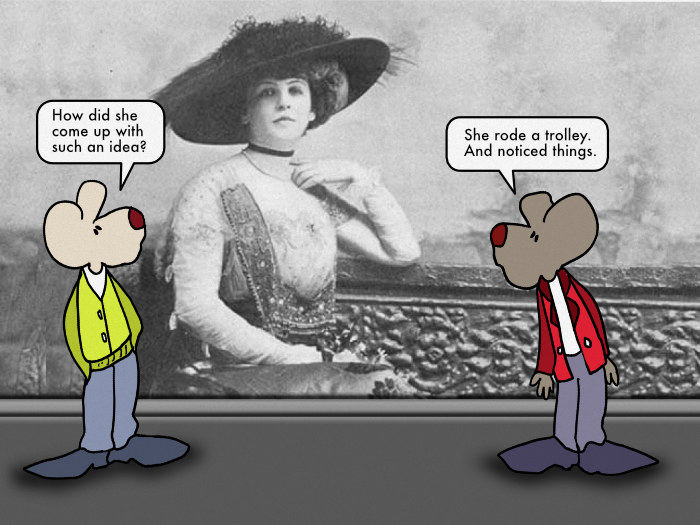It is something that has never been made before. Or the process of creating something that has never been made before. Invention.
Our world around us is inventions. That pencil. The computer you are using. Butter. Shoes. Roasting pans. Snow shovels. Dijon mustard. Toothpicks. All of it. Look around. Not one thing in our grasp came in with the Big Boom. Well. Not really. The molecules were there. But that is a different topic.
Anyway. The world is made up of inventions.
Historically, we celebrate the men of inventions. The Thomas Edisons. The Alexander Graham Bells. The Henry Fords.
But lots of women have been being the process of this too.
So today, let’s give those women a shout-out. They are underappreciated if you ask me. The women inventors.
First, I have to give a hearty thank you to Mary Anderson, for she invented the windshield wiper.
She was quite a woman. Mary Anderson was a rancher and vineyard operator back in the late 1800s. Then, in 1903, she patented the first effective set of windshield wipers.
The idea came to her when she was riding on a trolley car in New York City. They were driving through sleet at the time, and the driver had to leave the front windshield open, so he could see. But it left everyone in the trolly freezing cold. So she came up with the first working version of windshield wipers. They featured a rubber blade attached to a spring-loaded arm that could move across the windshield to clear snow, ice, and rain.
She received a patent for the device and attempted to sell the rights. But it never sold. The potential buyers didn’t see the use in it. Or perhaps they didn’t want to admit a woman had been a total smarty.
Mary Anderson lived 87 years. (1866-1953)
Next, we have Stephanie Kwolek. She devised the all-important invention of Kevlar.
Stephanie Kwolek studied chemistry. She wanted to become a doctor. Anyway, along the way took a research position with the DuPont company. While she was there, she was tinkering around with molecular combinations. With that, she created a very strong synthetic liquid crystalline polymer solution. This, in 1971. Her little concoction had the strength of five times that of steel. But. It was much lighter and resisted corrosion. Kevlar. We may not know it very well, but it is widely used in such things as bulletproof vests, safety helmets, camping gear, and even suspension bridges.
Stephanie Kwolek lived to be 90. (1923-2014)
And then we have Amanda Jones. Her great invention was vacuum packaging.
Amanda Jones didn’t invent food, obviously. She didn’t come up with a way to store it in jars, either. But she devised the way we store it — with the vacuum canning method. It became known as the Jones Method. Of course, this allows food to be preserved for much longer. And Amanda figured it out way back in 1872. Her method of canning permanently changed the food industry forever.
Amanda Jones stayed around for 78 years. (1835-1914)
I should also mention a few more.
Marion Donovan — the inventor of the disposable diaper in the late 1940s.
She lived 81 years. (1917-1998)
Bette Nesmith Graham — Liquid Paper (“White Out”)
Also, the mother of one of the Monkees — Peter Nesmith.
Bettie Nesmith Graham lived for a short 56 years. (1924-1980)
Patsy O’Connell Sherman — Scotchguard. During the 1950s.
Patsy O’Connell Sherman died at age 77. (1930-2008)
And finally, two of my favorites.
The first from my childhood.
A woman named Ruth Graves Wakefield invented Chocolate Chip Cookies.
She cooked for the Toll House tourist lodge outside of Boston, Massachusetts, beginning in 1930. According to historians, Ruth was attempting to make plain old chocolate cookies one day. But. Dang, it. She was fresh out of baking chocolate.
She chopped up some Nestle semi-sweet chocolate on the fly and tossed it into the cookie dough. She thought perhaps the chocolate would melt in nicely with the dough. But you all know what happened!
She called them Toll House Crunch Cookies. They quickly became a national sensation. And, of course, eventually, Wakefield and Nestle partnered to market Toll House Cookies. Nestle printed the recipe on their packages. They paid Wakefield with a lifetime supply of chocolate.
Ruth Graves Wakefield lived 73 years. (1903-1977)
And last but not least.
Josephine Cochrane invented the dishwasher. She came up with a rather primitive version at first. For obvious reasons — she was tired of doing the dishes. When the machine was unveiled in 1893, it consisted of a wooden box that would splash water on dishes using a hand crank. It took a little while for it to catch on and evolve. But it is a godsend to me. I love our dishwasher. I truly do.
Josephine Cochrane lasted here 74 years. (1839-1913)
Thanks to all these smart women.
And thanks to smart women everywhere, who invent new ways of living life, each and every day.
=====
Necessity… the mother of invention.
— Plato
=====
Nature is the source of all true knowledge. She has her own logic, her own laws, she has no effect without cause nor invention without necessity.
— Leonardo da Vinci
=====
Television is like the invention of indoor plumbing. It didn’t change people’s habits. It just kept them inside the house.
— Alfred Hitchcock
======
The ladies with the smart plans
